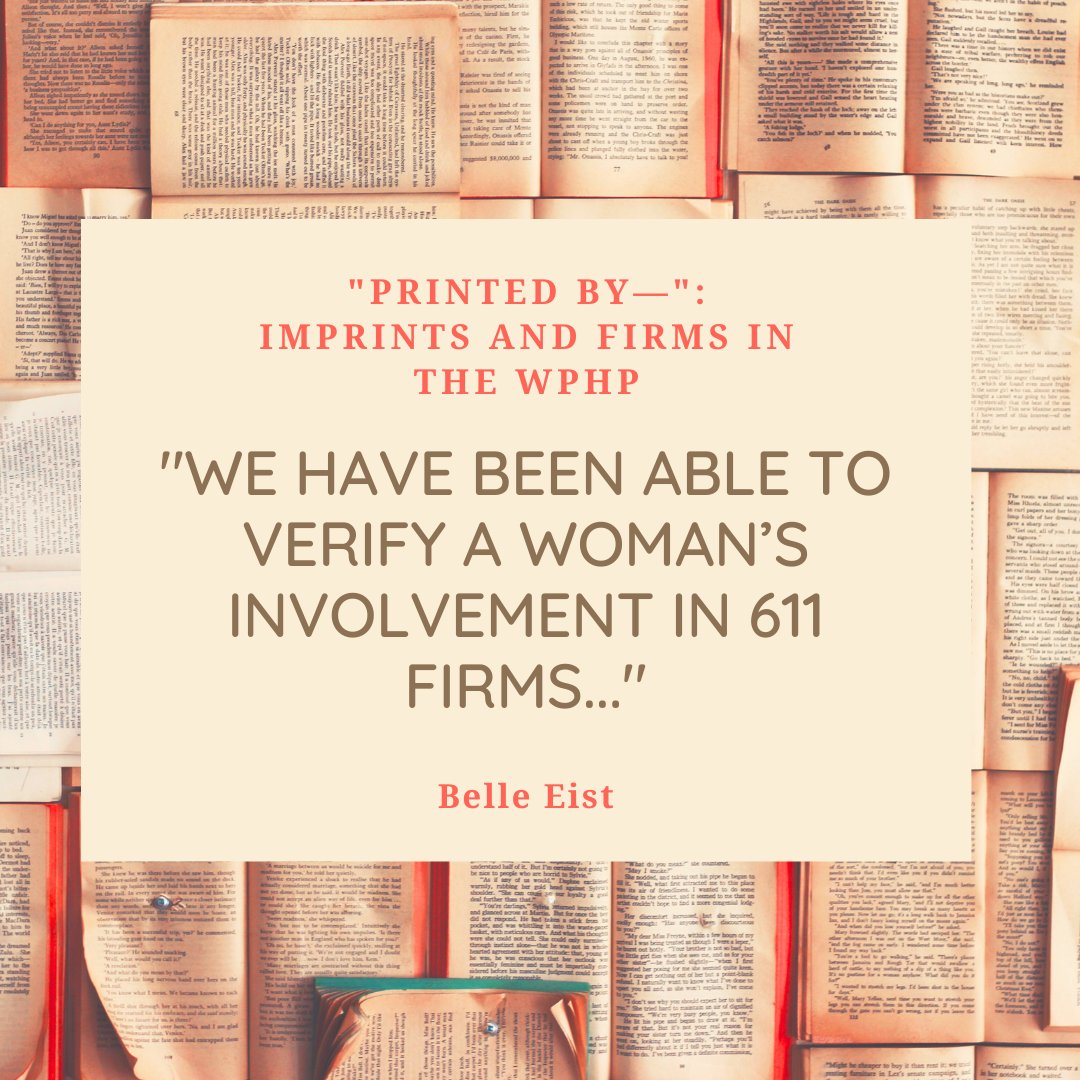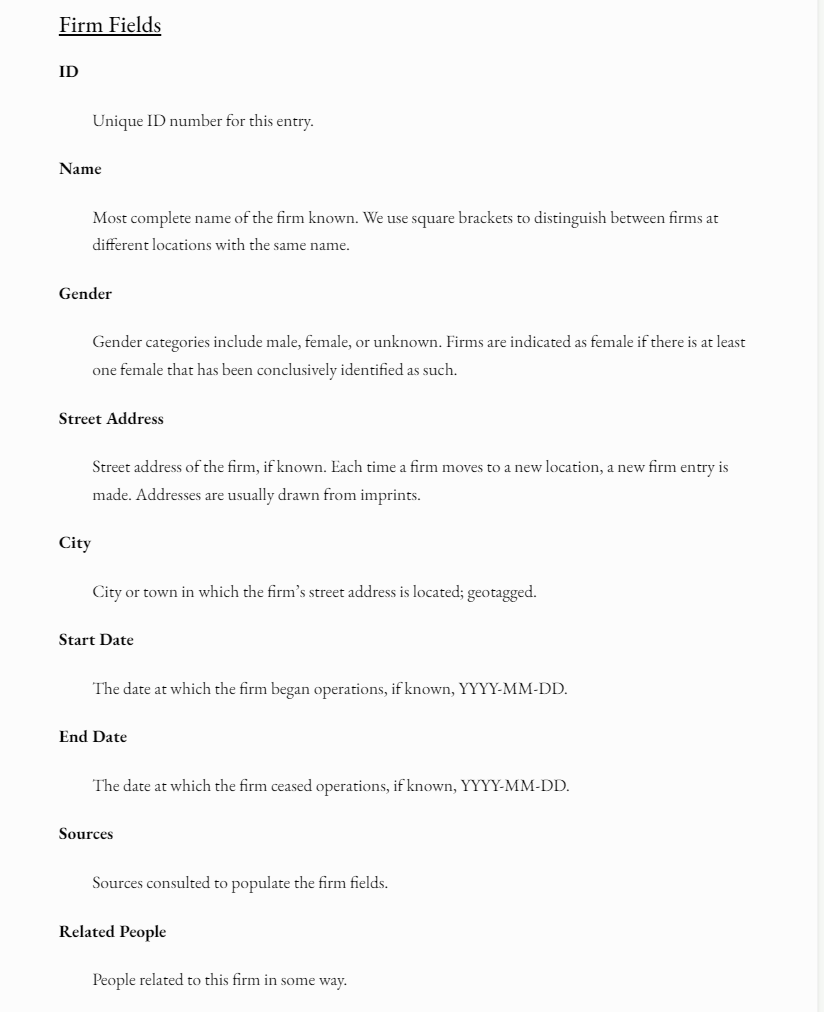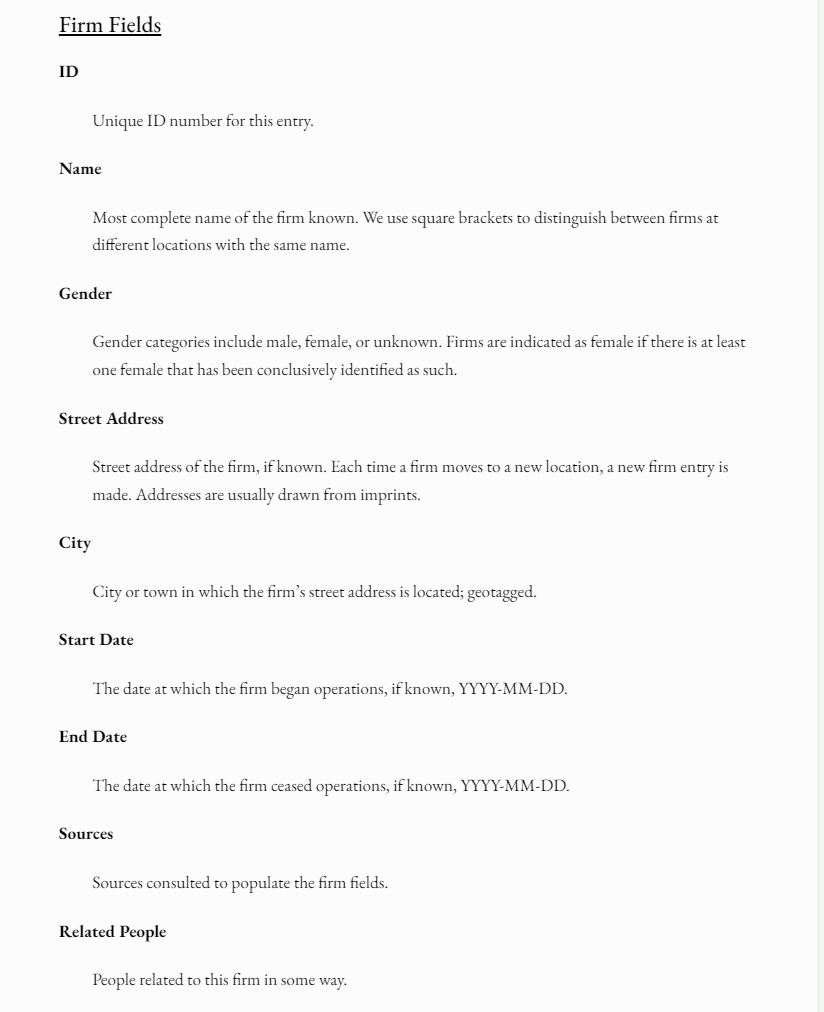This post is part of our By Our Books: Bibliography in the WPHP Spotlight Series, which will run through July 2023. This series attends to the bibliographical fields of the WPHP title records, tracing the history of our thinking about our descriptive practices and how they are informed by the sources available to us and by our feminist ambition to recognize and reconstruct women’s labour in print, broadly conceived.
Authored by: Isabella (Belle) Eist
Edited by: Michelle Levy, Kate Moffatt, and Kandice Sharren
Submitted on: 07/10/2023
Citation: Eist, Isabella. “'Printed by—': Imprints and Firms in the WPHP” The Women’s Print History Project, 10 July 2023, https://womensprinthistoryproject.com/blog/post/122.
 Figure 1. A quote from “'Printed by—': Imprints and Firms in the WPHP."
Figure 1. A quote from “'Printed by—': Imprints and Firms in the WPHP."
For our title records, the title page provides the key source of information, with the imprint providing critical information about the actors involved in the manufacture of the book. ABC for Book Collectors defines an imprint as “A notification to the reader (and to the legal authorities) of the person or persons responsible for the production of a book” (129). Likewise, in Book Parts, Shef Rogers notes that the “basic publisher imprint was the logical development from the colophon” and “consisted of several essential pieces of information: the publisher’s name and the location of the shop, the names of other booksellers involved in a book’s distribution (joint publication shared the risk and increased market reach), and the place and date of publication” (55, 56). We use the imprint field to identify the publishers, printers, and booksellers involved in the production of the title. Imprints tell us the firm’s name and their address or city of operation (which, interestingly, occasionally differs from a title’s location of printing), and usually also tell us the role the business played: for most of the period we cover, “printed by” references the printer, “printed for,” the publisher, and “sold by,” the bookseller. In the earlier eighteenth century, however, these descriptors are less stable, as Kate Ozment has discussed in her spotlight on Ann Dodd. Nevertheless, the imprint provides crucial information for us, which we use to link in our title records. Each title contains separate entries for each firm that can be identified as being part of the manufacture of the title in question.
Most often, this information is taken directly from the imprint and colophon. However, we compare and supplement this information by consulting our firm sources—including the Oxford Dictionary of National Biography, The Exeter Working Papers, British Book Trade Index, The Scottish Book Trade Index, The London Book Trades, 1800-1850, A Dictionary of Members of the Dublin Book Trade, 1550-1800, and Wikipedia—which provide additional information, such as start and end dates of operation, specific addresses, and full names, often beyond what may be included in a title’s imprint or colophon.
Before we can add links to firms and indicate their roles in our title records, the firm must have a record in our firm table. A list of the information we attempt to capture about firms may be seen in our documentation, copied below. We must be careful to ascertain that we attach the correct firm record in the case of book trade businesses that operated over many years, at multiple locations, or under shifting names. Our firms field links to individual records within our firms table, documenting the book-trade businesses listed across both the imprint and colophon.

Figure 2. The WPHP’s Firms Documentation.
Including the addresses and the start and end dates of a firm’s operations within our firm records (when that information can be found in imprints and through the secondary sources the WPHP consults) helps editors and viewers of the database distinguish between firms; for book trade businesses with especially long and prolific careers—often operating out of a number of different addresses or under changing partnerships across marriages and deaths—attaching the most accurate firm record to a title entry is an important feature of the WPHP’s data model. The city and address fields recorded in imprints help us to pinpoint which specific firm produced a corresponding title. For example, as the following screen capture of Elizabeth Boyle’s multiple firm records depicts, she operated at seven different locations over a 21-year period. Using the imprint to see the date and address are often the only way we can discern which firm record to attach to a specific title.

Figure 3. Screen Capture of the WPHP Firms Table for “Elizabeth Boyle” as of June 2023.
Although an imprint typically includes the location and date of publication, we parse these into their own fields. Differentiating the city and date of publication from the remainder of the imprint in our title records enables further refinement through the advanced search feature, increasing the accessibility and discoverability of our data for those looking for bibliographic data on titles published in a specific locale.
Our firm records also note the gender of those involved in the operation of the firm, when known. This is an important designation for firms and persons records alike in the WPHP. Book trade businesses run by or involving women are linked in our title records to both their firms record and their persons record in the contributor field. As our 2022 “Down the Rabbit Hole: Researching Women in the Book Trades” Spotlight Series emphasized, many women working in the book trades throughout the long eighteenth century were hidden behind their husband’s names or were only represented by a first initial in imprints, making it difficult to confirm a woman’s involvement. The majority of the WPHP’s 5143 verified firms maintain an unknown gender designation—this is because our default gender, rather than being male, is unknown. We do this so as not to replicate assumptions about men dominating the book trades. Thus far, we have been able to verify a woman’s involvement in 611 firms using our sources or data from imprints and colophons in our title records. Combing through our firm sources has enabled the WPHP to create records for women-run book trade businesses operating between 1700 and 1836 who are not linked to any titles currently in our database. In addition to women working as publishers, printers, and booksellers, some firm records created from our sources also account for women working as stationers, as many performed multiple roles within the book trades sphere.
WPHP Records Referenced
"What Does it Mean to Publish? A Messy Accounting of Anne Dodd" (spotlight by Kate Ozment)
Firms (field)
Firms Documentation (methodology)
Boyle, Elizabeth (person)
"Down the Rabbit Hole: Researching Women in the Book Trades Spotlight Series" (spotlight series introduction)
Works Cited
Carter, John, and Nicolas Barker. ABC for Book Collectors. 8th ed., Oak Knoll Press and The British Library, 2004.
Rogers, Shef. “Book Parts: Imprints, Imprimaturs, and Copyright Pages.” Book Parts, edited by Dennis Duncan and Adam Smyth, Oxford UP, 2019, pp. 51–64.
